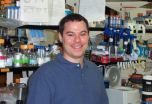(Press-News.org) New genes that have evolved in species as little as one million years ago – a virtual blink in evolutionary history – can be just as essential for life as ancient genes, startling new research has discovered.
Evolutionary biologists have long proposed that the genes most important to life are ancient and conserved, handed down from species to species as the "bread and butter" of biology. New genes that arise as species split off from their ancestors were thought to serve less critical roles – the "vinegar" that adds flavor to the core genes.
But when nearly 200 new genes in the fruit fly species Drosophila melanogaster were individually silenced in laboratory experiments at the University of Chicago, more than 30 percent of the knockdowns were found to kill the fly. The study, published December 17 in Science, suggests that new genes are equally important for the successful development and survival of an organism as older genes.
"A new gene is as essential as any other gene; the importance of a gene is independent of its age," said Manyuan Long, PhD, Professor of Ecology & Evolution and senior author of the paper. "New genes are no longer just vinegar, they are now equally likely to be butter and bread. We were shocked."
The study used technology called RNA interference to permanently block the transcription of each targeted gene into its functional product from the beginning of a fly's life. Of the 195 young genes tested, 59 were lethal (30 percent), causing the fly to die during its development. When the same method was applied to a sample of older genes, a statistically similar figure was found: 86 of 245 genes (35 percent) were lethal when silenced.
Because the young genes tested only appeared between 1 and 35 million years ago, the data suggests that new genes with new functions can become an essential part of a species' biology much faster than previously thought. A new gene may become indispensable by forming interactions with older genes that control important functions, said Sidi Chen, University of Chicago graduate student and first author of the study.
"New genes come in and quickly interact with older genes, and if that interaction is favorable by helping the organism survive or reproduce better, it is favored by natural selection and stays in the genome," Chen said. "After a while, it becomes essential, and the organism literally cannot live without the gene any more. It's something like love: You fall in love with someone and then you cannot live without them."
The indispensable nature of new genes also questions long-held beliefs about the shared features of development across different species. In 1866, German zoologist Ernst Haeckel famously hypothesized that "ontogeny recapitulates phylogeny" after observing that the early steps of development are shared by animals as different as fly and man.
Biologists subsequently predicted and confirmed that the same ancient, essential genes would be the conductors of this early development in all species. This principle enabled the use of model organisms, including flies, mice, and rats, to be used for research on the mechanisms of human disease.
Intriguingly, in the new study, deleting many of the new genes causes flies to die during middle or late stages of development, while older genes were lethal during early development. So while ancient genes essential for the early steps of development are shared, newer genes unique to each species may take over the later developmental stages that make each species unique. For example, many new genes in the study were found to be involved with metamorphosis, the mid-life stage that drastically transforms the body plan in animals.
"This may change the way we view the developmental program," Long said. "Each species has a different species-specific developmental program shaped by natural selection, and we can no longer say that from Drosophila to humans the development of different organisms is just encoded by the same genetic program. The story is much more complicated than what we used to believe."
As such, a full understanding of biological diversity may require a new focus on genes unique to each organism.
"I think it has important implications on human health," Chen said. "Animal models have proven to be very useful and important for dissecting human disease. But if our intuition is correct, some important health information for humans will reside in the unique parts of the human genome."
The newfound importance of young genes and unique developmental programs may have a dramatic impact on the field, Long said. The discovery will also inspire new research directions examining how quickly new genes can become essential and their exact role in species-specific development.
"Biologists have long assumed, quite reasonably, that ancient genes have survived natural selection because they are essential to life and that new genes are generally less critical to an organism's development," said Irene Eckstrand, PhD, who manages Dr. Long's and other evolutionary biology grants at the National Institutes of Health. "This important study suggests that this assumption is flawed, unlocking new questions that could lead to a deeper understanding of evolutionary processes and their impact on human health."
###
The study, "New genes in Drosophila quickly become essential," is published in the December 17 issue of Science. Chen, Long, and Yong Zhang of the University of Chicago are authors of the study.
The work was funded by grants from the National Institute of General Medical Sciences, the National Science Foundation, and the Chicago Biomedical Consortium.
PHOTOS AVAILABLE ON REQUEST
END
Gamma-ray bursts (GRBs), fleeting events that last from less than a second to several minutes, are detected by orbiting observatories that can pick up their high energy radiation. Thirteen years ago, however, astronomers discovered a longer-lasting stream of less energetic radiation coming from these violent outbursts, which can last for weeks or even years after the initial explosion. Astronomers call this the burst's afterglow.
While all gamma-ray bursts [1] have afterglows that give off X-rays, only about half of them were found to give off visible light, with the ...
Nearly two-thirds of Medicare beneficiaries discharged from hospitals after ischemic stroke die or are readmitted within one year, researchers report in Stroke: Journal of the American Heart Association.
Stroke is the second leading cause of hospital admissions among older adults in the United States, according to American Heart Association/American Stroke Association statistics. Ischemic stroke, which occurs as a result of an obstruction within a blood vessel supplying blood to the brain, accounts for 87 percent of all strokes.
Only a few contemporary studies have ...
A UCLA-led has study found that after leaving the hospital, nearly two-thirds of Medicare beneficiaries hospitalized for acute ischemic stroke either died or were rehospitalized within a year.
The findings point to an opportunity for more quality-of-care initiatives to improve stroke care, especially in transitioning to home, stroke rehabilitation and outpatient care.
The study, which appears online Dec. 16 in Stroke, a journal of the American Heart Association, also found that hospital mortality and readmission rates varied widely nationwide, indicating there ...
Researchers from Mount Sinai School of Medicine have found that when one copy of the SHANK3 gene in mice is missing, nerve cells do not effectively communicate and do not show cellular properties associated with normal learning. This discovery may explain how mutations affecting SHANK3 may lead to autism spectrum disorders (ASDs). The research is currently published in Molecular Autism.
"We know that SHANK3 mutation plays a central, causative role in some forms of autism spectrum disorders, but wanted to learn more about how it does this," said Joseph Buxbaum, PhD, Director ...
CHAPEL HILL, N.C. – The function of histones -- the proteins that enable yards of DNA to be crammed into a single cell -- depends on a number of chemical tags adorning their exterior. This sophisticated chemical syntax for packaging DNA into tight little coils or unraveling it again -- called the "histone code" -- is the latest frontier for researchers bent on understanding how genetics encodes life.
But recent research from the University of North Carolina at Chapel Hill has found a number of issues with histone antibodies, the main tools used to decipher this code, ...
A research team from the Institut Català de Nanotecnologia (ICN), in Barcelona, has demonstrated a device that induces electron spin motion without net electric currents, a key step in developing the spin computers of the future. The results are published in the Dec 17 issue of the journal Science. The authors are Marius V. Costache and Sergio O. Valenzuela, an ICREA Professor who is leader of the Physics and Engineering of Nanodevices Group at ICN.
Spintronics is a branch of electronics that aims to use the electron spin rather than its charge to transport and store ...
The research project 'Older People's Use of Unfamiliar Space' (OPUS) examined the strategies used by older people to find their way in unfamiliar spaces as pedestrians and users of public transport. As part of the research, older people were shown town scenes and pedestrian routes and gave feedback on signposting, ease of navigation and general impressions. Their heart rates were measured to monitor stress levels. Participants were also taken to a town centre to walk through the same routes in person.
Initial findings show:
Signs are of limited use even in unfamiliar ...
Scientists at the Johns Hopkins Kimmel Cancer Center have deciphered the genetic code for medulloblastoma, the most common pediatric brain cancer and a leading killer of children with cancer. The genetic "map" is believed to be the first reported of a pediatric cancer genome and is published online in the December 16 issue of Science Express.
Notably, the findings show that children with medulloblastoma have five- to tenfold fewer cancer-linked alterations in their genomes compared with their adult counterparts, the scientists say.
"These analyses clearly show that ...
Pediatric cancer researchers at The Children's Hospital of Philadelphia contributed important expertise to a new landmark study of medulloblastoma, a type of brain tumor typically found in children. The large multicenter study defines the genetic landscape of this cancer, and holds intriguing clues to gene changes on signaling pathways that may become fruitful targets for future therapies.
The most common cancerous brain tumor in children, medulloblastoma is, fortunately, rare. However, it causes significant mortality, and survivors may suffer serious long-term side effects ...
AMES, Iowa – Advancements in fabrication technologies may lead to superlenses and other designer optical materials, according to an Iowa State University and Ames Laboratory physicist.
In an article titled "Improving Metamaterials" published in the Perspectives section of the Dec. 17 issue of the journal Science, Costas Soukoulis and Martin Wegener write about the man-made materials designed to deliver certain properties not found in nature.
Soukoulis is an Iowa State University Distinguished Professor and Frances M. Craig Professor of Physics and Astronomy and a senior ...


